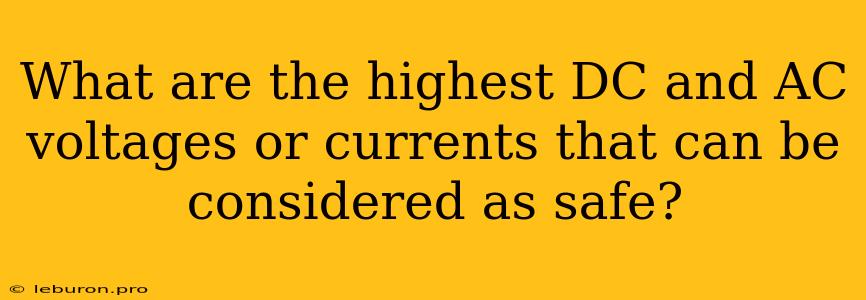Electricity is a powerful force that can be both beneficial and dangerous. While it powers our homes, businesses, and devices, it can also cause severe injury or even death if not handled properly. Understanding the safety limits of electrical current and voltage is crucial for preventing accidents and ensuring the well-being of individuals. While there is no universally accepted "safe" level of electricity, as it depends on various factors, this article explores the considerations regarding the highest DC and AC voltages or currents that can be generally considered safe.
Factors Influencing Electrical Safety
Determining the safe limits for electrical current and voltage is complex and depends on multiple factors, including:
- Path of the Current: The route the current takes through the body significantly affects its impact. A current flowing through the heart is far more dangerous than one traveling through a limb.
- Duration of Exposure: The length of time an individual is exposed to electrical current plays a crucial role in the severity of the effects. Short exposures may cause minor sensations, while prolonged exposures can lead to serious injuries.
- Individual Sensitivity: Individuals have varying levels of sensitivity to electrical currents. Factors such as age, health condition, and body composition can influence how a person reacts to electrical shock.
- Frequency of the Current: Alternating Current (AC) is generally more dangerous than Direct Current (DC) at the same voltage due to its pulsating nature. AC current can cause muscle contractions, making it difficult for individuals to break free from the source.
AC Voltage and Current Safety
General Guidelines for AC Voltages
- Low-Voltage Circuits (Less than 50V): Generally considered safe for household use and touch-safe in normal conditions.
- Extra-Low Voltage (SELV - Less than 12V): Typically used in toys, appliances, and devices considered safe even for direct contact.
- Standard Household AC Voltage (120V - 240V): Can be extremely dangerous, and contact with these circuits should always be avoided.
- High Voltage (Above 600V): Extremely hazardous, and contact with these circuits can be fatal.
AC Current Considerations
- Below 1mA: Generally considered a threshold where a person may feel a tingling sensation but no significant harm.
- 1mA to 10mA: Can cause muscle contractions and discomfort.
- 10mA to 20mA: Painful shocks and potential for muscle paralysis.
- 20mA to 100mA: Ventricular fibrillation (a life-threatening heart rhythm disturbance) becomes a significant risk.
- Above 100mA: Cardiac arrest and severe burns are highly likely.
DC Voltage and Current Safety
General Guidelines for DC Voltages
- Low-Voltage DC (Less than 50V): Similar to AC, generally considered safe for household use and touch-safe in normal conditions.
- Extra-Low Voltage (SELV - Less than 12V): Widely used in electronics, such as USB devices, and generally considered safe for direct contact.
- High-Voltage DC (Above 600V): Extremely hazardous, and contact with these circuits can be fatal.
DC Current Considerations
- Below 1mA: Generally considered safe, but some individuals might experience a tingling sensation.
- 1mA to 10mA: Can cause muscle contractions and discomfort, similar to AC.
- Above 10mA: Significant risk of electrical burns, muscle paralysis, and potential for cardiac arrest.
Considerations for Safety Standards
Safety standards for electrical systems are established by organizations like the National Electrical Code (NEC) in the United States and IEC standards internationally. These standards define safe operating voltages, current limits, and installation guidelines to minimize the risk of electrical hazards.
Minimizing Electrical Risks
Here are some essential safety measures to reduce the risk of electrical hazards:
- Respect Electrical Wiring: Never attempt to repair or modify electrical wiring without proper training and certification.
- Use Ground Fault Circuit Interrupters (GFCIs): These devices are designed to interrupt electrical current in the event of a fault, reducing the risk of electrocution.
- Avoid Water and Electrical Appliances: Never use electrical appliances near water or with wet hands. Water can conduct electricity and increase the risk of shock.
- Properly Insulate Wiring: Ensure all electrical wires and connections are properly insulated to prevent accidental contact.
- Inspect Electrical Devices: Regularly inspect electrical devices for damage to cords, plugs, or other components.
- Be Aware of Overhead Power Lines: Stay clear of overhead power lines, as they can carry extremely high voltages.
Conclusion
While there is no absolute "safe" level of electrical current or voltage, understanding the factors that influence electrical safety is crucial. By following safety standards, using proper electrical equipment, and being aware of potential hazards, individuals can significantly minimize the risk of electrical accidents. Remember, electricity is a powerful force that should be treated with respect and caution. Always err on the side of safety, and never hesitate to contact a qualified electrician for any electrical work.
